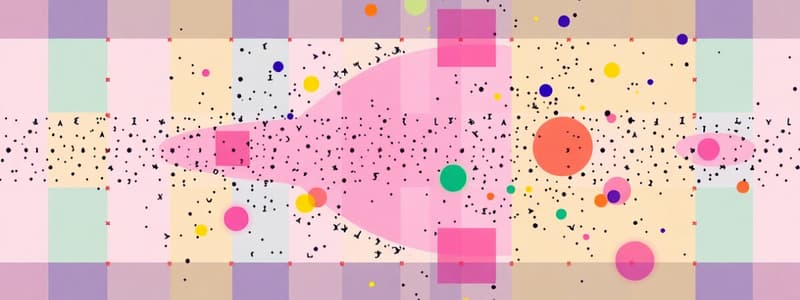Podcast
Questions and Answers
Which category of drugs is primarily known for reducing symptoms of psychosis?
Which category of drugs is primarily known for reducing symptoms of psychosis?
- Anxiolytics
- Antipsychotics (correct)
- Mood Stabilizers
- Muscle Relaxants
Which neurotransmitter system is primarily affected by benzodiazepines?
Which neurotransmitter system is primarily affected by benzodiazepines?
- Dopamine
- GABA (correct)
- Norepinephrine
- Serotonin
What is a potential long-term neurological effect associated with chronic substance abuse?
What is a potential long-term neurological effect associated with chronic substance abuse?
- Increased Neuroplasticity
- Enhanced Cognitive Function
- Korsakoff's Syndrome (correct)
- Decreased Risk of Seizures
Which of the following is an example of a 'minor tranquilizer'?
Which of the following is an example of a 'minor tranquilizer'?
What distinguishes 'latanogenic addiction' from other forms of addiction?
What distinguishes 'latanogenic addiction' from other forms of addiction?
Which effect is most closely associated with activation of the sympathetic nervous system (SNS)?
Which effect is most closely associated with activation of the sympathetic nervous system (SNS)?
Which of the following responses is a likely psychological symptom induced by hallucinogens?
Which of the following responses is a likely psychological symptom induced by hallucinogens?
Which of the following drugs is categorized as a 'club drug'?
Which of the following drugs is categorized as a 'club drug'?
Which of these substances is described as producing effects that 'mimic the effects of serotonin'?
Which of these substances is described as producing effects that 'mimic the effects of serotonin'?
Which of the following refers to a class of drugs used to relax skeletal muscles?
Which of the following refers to a class of drugs used to relax skeletal muscles?
Which of the following statements accurately describes the action of LSD?
Which of the following statements accurately describes the action of LSD?
Which of the following best describes the mechanism of action of anti-anxiety drugs?
Which of the following best describes the mechanism of action of anti-anxiety drugs?
What is a common mechanism of action shared among hallucinogenic compounds like psilocybin and mescaline?
What is a common mechanism of action shared among hallucinogenic compounds like psilocybin and mescaline?
Which of the following is a defining characteristic of hallucinogens as a drug class?
Which of the following is a defining characteristic of hallucinogens as a drug class?
Which condition is most associated with the extrapyramidal side effects of some medications?
Which condition is most associated with the extrapyramidal side effects of some medications?
A drug that is described as leading to 'reverse tolerance' implies what kind of effect?
A drug that is described as leading to 'reverse tolerance' implies what kind of effect?
What is the primary mechanism by which Cannabis Sativa is known for its hallucinogenic properties?
What is the primary mechanism by which Cannabis Sativa is known for its hallucinogenic properties?
What is the mechanism of action of psychotomimetics?
What is the mechanism of action of psychotomimetics?
What is the most likely reason for the high addiction potential of bezodiazepines?
What is the most likely reason for the high addiction potential of bezodiazepines?
Which of the following is an effect of smooth muscle constriction?
Which of the following is an effect of smooth muscle constriction?
Flashcards
Hallucinogen Effects
Hallucinogen Effects
Mimics the effects of a psychosis. Effects divided into four categories: 1) SNS: striped musculature, e.g., ataxia, spasticity 2) ANS: tachycardia, hyperthermia 3) Smooth musculature: blood vessel constriction 4) Psychological: psychotic symptoms
Phantasticants/Psychedelics
Phantasticants/Psychedelics
Hallucinogens that create the experience of the "fantastic". These compounds all possess an indole ring mimicking the effects of serotonin, e.g., psilocybin (mushrooms), mescaline (peyote). Often used to create religious experiences
LSD
LSD
LSD (lysergic acid diethylamide) also known as "acid, dose, alice.", contains an indole ring and inhibits neural activity at the raphe nuclei in the brain.
Antipsychotics
Antipsychotics
Signup and view all the flashcards
Mood Stabilizers
Mood Stabilizers
Signup and view all the flashcards
Tranquilizers-Minor
Tranquilizers-Minor
Signup and view all the flashcards
Benzodiazepines
Benzodiazepines
Signup and view all the flashcards
Muscle Relaxants
Muscle Relaxants
Signup and view all the flashcards
Study Notes
Introduction to Probability
- An experiment is an activity that has an observable outcome.
- Examples include tossing a coin, drawing a card from a deck, or rolling a die.
- Sample space is the set of all possible outcomes of an experiment.
- Coin toss sample space : $S = {H, T}$
- Sample space for drawing a card from a deck: $S = {A\clubsuit, K\clubsuit,..., 2\clubsuit, A\diamondsuit, K\diamondsuit,..., 2\diamondsuit, A\heartsuit, K\heartsuit,..., 2\heartsuit, A\spadesuit, K\spadesuit,..., 2\spadesuit}$
- Die roll sample space: $S = {1, 2, 3, 4, 5, 6}$
- An event is a subset of the sample space.
- An event in a coin toss could be: observing a Head, $E = {H}$
- An event in card drawing could be: observing an Ace, $E = {A\clubsuit, A\diamondsuit, A\heartsuit, A\spadesuit}$
- An event in die rolling could be: observing an even number, $E = {2, 4, 6}$
Axioms of Probability
- The probability of any event is a real number between 0 and 1: $0 \le P(E) \le 1$
- The probability of the sample space is 1, $P(S) = 1$
- For mutually exclusive events $E_1, E_2, E_3,...$, $P(E_1 \cup E_2 \cup E_3 \cup...) = P(E_1) + P(E_2) + P(E_3) +...$
Rules of Probability
- The probability of the null set is 0: $P(\emptyset) = 0$
- For events E and F, $P(E \cup F) = P(E) + P(F) - P(E \cap F)$
- For mutually exclusive events E and F, $P(E \cup F) = P(E) + P(F)$
- If E and $E^c$ are complementary events then: $P(E^c) = 1 - P(E)$
Discrete Probability
-
For a discrete random variable X, Probability Mass Function (PMF) provides the probability that X takes a specific value x: $p(x) = P(X = x)$
-
Properties of PMF:
- $0 \le p(x) \le 1$
- $\sum_{x}^{} p(x) = 1$
-
For a discrete random variable X, Cumulative Distribution Function (CDF) provides the probability that X takes on a value less than or equal to x.
$F(x) = P(X \le x) = \sum_{u \le x}^{}p(u)$
-
Properties of CDF:
- $0 \le F(x) \le 1$
- $F(x)$ is a non-decreasing function
Continuous Probability
- For a continuous random variable X, Probability Density Function (PDF) is a function such that:
- $P(a \le X \le b) = \int_{a}^{b} f(x)dx$
- The properties for a PDF ( Probability Density Function ):
- $f(x) \ge 0$
- $\int_{-\infty}^{\infty} f(x)dx = 1$
- For a continuous random variable X, Cumulative Distribution Function (CDF) is defined as
- $F(x) = P(X \le x) = \int_{-\infty}^{x}f(u)du$
- Properties of CDF:
- $0 \le F(x) \le 1$
- $F(x)$ is a non-decreasing function
Vectores (Vectors - Spanish)
- A Vector is a line segment with orientation that has magnitude, direction and orientation.
- A Vector $\vec{A}$ is defined by its components $A_x$ and $A_y$: $\vec{A} = (A_x, A_y)$
- $A_x = A \cos \theta$
- $A_y = A \sin \theta$
- $A = \sqrt{A_x^2 + A_y^2}$
- $\theta = \tan^{-1} \left( \frac{A_y}{A_x} \right)$
Sum of Vectors
- Given two vectors $\vec{A} = (A_x, A_y)$ and $\vec{B} = (B_x, B_y)$, their sum is: $\vec{A} + \vec{B} = (A_x + B_x, A_y + B_y)$
Dot Product
- Given two vectors $\vec{A}$ and $\vec{B}$, their dot product is $\vec{A} \cdot \vec{B} = |\vec{A}| |\vec{B}| \cos \theta = A_x B_x + A_y B_y + A_z B_z$
- $\theta$ is the angle between $\vec{A}$ and $\vec{B}$
Cross Product
- For two vectors $\vec{A}$ and $\vec{B}$, their cross product results in a vector $\vec{C}$ defined as $\vec{C} = \vec{A} \times \vec{B}$.
- Magnitude: $|\vec{C}| = |\vec{A}| |\vec{B}| \sin \theta$
- Direction: Perpendicular to the plane formed by $\vec{A}$ and $\vec{B}$.
- Sense: According to the right-hand rule.
- Components:
- $\vec{A} \times \vec{B} = (A_y B_z - A_z B_y, A_z B_x - A_x B_z, A_x B_y - A_y B_x)$
- $\vec{A} \times \vec{B} = \begin{vmatrix} \hat{i} & \hat{j} & \hat{k} \ A_x & A_y & A_z \ B_x & B_y & B_z \end{vmatrix}$
- $\hat{i}$, $\hat{j}$ and $\hat{k}$ are the unit vectors in the directions x, y, and z, respectively.
Studying That Suits You
Use AI to generate personalized quizzes and flashcards to suit your learning preferences.




